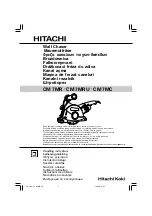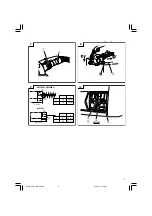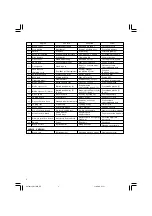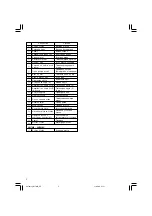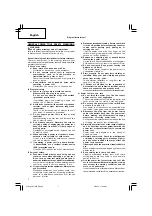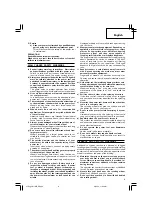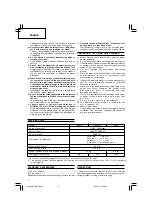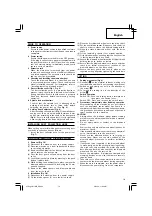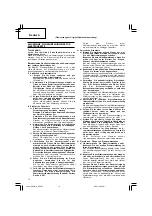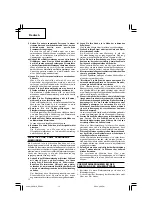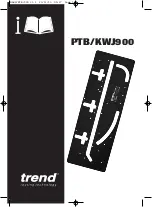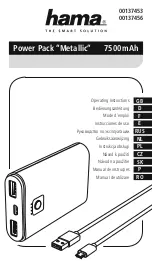
11
English
MAINTENANCE AND INSPECTION
1. Inspection the diamond wheel
A worn diamond wheel overloads the motor and
reduces working efficiency. Replace with a new one.
2. Diamond wheel clogging
The rate of wear of the diamond layer cutting edge
will vary depending on the type of material being
cut, the cutting speed, etc. In general, materials
which produce granular cutting particles may scrape
the bodying agent and hasten the wear of the
diamond layer. On the other hand, materials which
produce powdery cutting particles may cause
clogging of the diamond layer which will reduce
cutting efficiency. When clogging occurs, additional
force applied in an attempt to increase cutting speed
will sometime cause sparks to appear around the
circumference of the diamond wheel. In such a case,
stop using the cutter and carefully inspect the cutting
edge by rubbing it with your fingers. If the diamond
layer feels smooth (no roughness or abrasiveness),
it is clogged with dust and must be “dressed”.
For thorough dressing, approximately 5 meters of
slightly accelerated cutting at a depth of 10mm in
a relative soft material which produces granular
cutting particles (such as a cement block or brick)
will restore the cutting effectiveness of the diamond
layer and will extend the service life of the diamond
wheel.
The diamond material is susceptible to high
temperatures and will begin to deteriorate at
approximately 600°C. Higher temperatures will cause
decomposition of the diamond material. Accordingly,
it is important to perform “dressing” as soon as
clogging or sparking occurs.
3. Inspecting the mounting screws
Regularly inspect all mounting screws and ensure
that they are properly tightened. Should any of the
screws be loose, retighten them immediately. Failure
to do so could result in serious hazard.
4. Maintenance of the motor
The motor unit winding is the very “heart” of the
power tool.
Exercise due care to ensure the winding does not
become damaged and/or wet with oil or water.
5. Inspecting the carbon brushes (Fig. 9)
The motor employs carbon brushes which are
consumable parts.
When they become worn to or near the “wear
limit”, it could result in motor trouble. When an
auto-stop carbon brush is equipped, the motor will
stop automatically.
At that time, replace both carbon brushes with new
ones which have the same carbon brush numbers
shown in the figure. In addition, always keep carbon
brushes clean and ensure that they slide freely within
the brush holders.
6. Replacing carbon brushes
CM7MC (Fig. 10)
<Disassembly>
(1) Loosen the D4 tapping screw retaining the brush
cover and remove the brush cover.
(2) Use the auxiliary hexagonal wrench or small
screwdriver to pull up the edge of the spring that
is holding down the carbon brush. Remove the edge
of the spring toward the outside of the brush holder.
(3) Remove the end of the pig-tail on the carbon brush
from the terminal section of brush holder and then
remove the carbon brush from the brush holder.
<Assembly>
(1) Insert the end of the pig-tail of the carbon brush
in the terminal section of brush holder.
(2) Insert the carbon brush in the brush holder.
(3) Use the auxiliary hexagonal wrench or small
screwdriver to return the edge of the spring to the
head of the carbon brush.
(4) Mount the brush cover and tighten the D4 tapping
screw.
CM7MR • CM7MRU
Disassemble the brush cap with a slotted-head
screwdriver. The carbon brush can then be easily
removed.
7. Service parts list
CAUTION
Repair, modification and inspection of Hitachi Power
Tools must be carried out by a Hitachi Authorized
Service Center.
This Parts List will be helpful if presented with the
tool to the Hitachi Authorized Service Center when
requesting repair or other maintenance.
In the operation and maintenance of power tools,
the safety regulations and standards prescribed in
each country must be observed.
MODIFICATIONS
Hitachi Power Tools are constantly being improved
and modified to incorporate the latest technological
advancements.
Accordingly, some parts may be changed without
prior notice.
GUARANTEE
We guarantee Hitachi Power Tools in accordance with
statutory/country specific regulation. This guarantee does
not cover defects or damage due to misuse, abuse, or
normal wear and tear. In case of complaint, please send
the Power Tool, undismantled, with the GUARANTEE
CERTIFICATE found at the end of this Handling instruction,
to a Hitachi Authorized Service Center.
NOTE
Due to HITACHI’s continuing program of research and
development, the specifications herein are subject to
change without prior notice.
Information concerning airborne noise and vibration
The measured values were determined according to
EN60745 and declared in accordance with ISO 4871.
Measured A-weighted sound power level: 110 dB (A).
Measured A-weighted sound pressure level: 99 dB (A).
Uncertainty KpA: 3 dB (A).
Wear hearing protection.
Vibration total values (triax vector sum) determined
according to EN60745.
Vibration emission value
a
h
= 7.4 m/s
2
Uncertainty K = 1.5 m/s
2
01Eng_CM7MR_EE.p65
2/25/14, 11:25 AM
11

